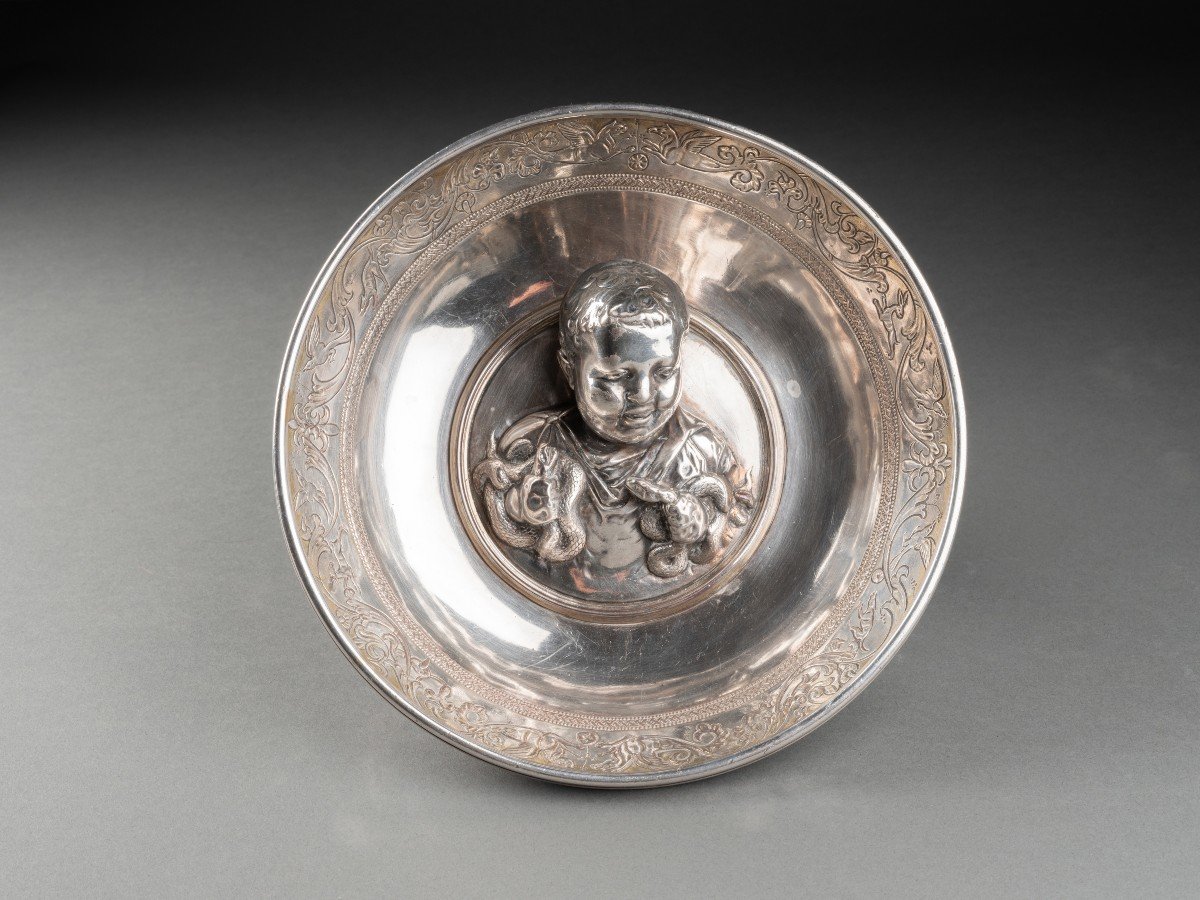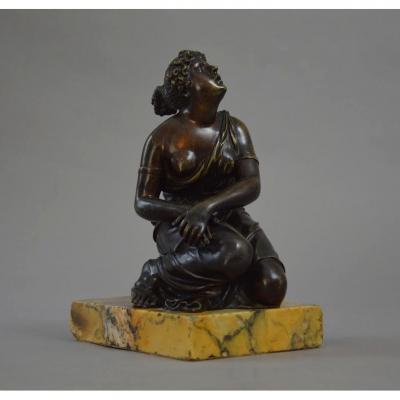Cup from the Hildesheim treasure, decorated with a figure of Hercules as a child.
Silver-plated copper.
H. 7 - D. 21.5 cm.
1868.
Patera bowl with high-relief decoration depicting a bust of a child Hercules grasping snakes. The rim is decorated with an engraved frieze of scrolling plants and animals.
Archaeologist François Lenormant, one of the first French commentators on the Hildesheim treasure, commented on our bowl in 1869 in the Gazette des Beaux-Arts:
"It is very much the art of the time of Augustus that is offered to us by another peg [...] whose emblema shows a bust of Hercules as a child, entirely in the round. The young god, with a smile on his lips, smothers the snakes that the jealous Juno has sent into his cradle to give him death."
As for Christofle's facsimiles, thanks to which these bowls, jealously guarded in the Berlin Museums, could be appreciated in the rest of France and Europe:
[For some time, however, we in France knew of the Hildesheim discovery only through the echo of the immense impact it had beyond the Rhine, through deliberately incomplete descriptions [...], and through rather poor photographs published in Berlin based on plaster casts. This is no longer the case today. The admirable reproductions recently produced by Christofle et Cie, and currently on display at the exhibition of the Union centrale des Beaux-Arts appliqués à l'industrie, will make the vases found in Hanover popular in our country (Lenormant, p. 408 ff.).
The quality of the work carried out by the French silversmith is not lost on the editor:
"In accordance with a custom quite usual to ancient chisellers [...] all the parts are gilded with fire, with the exception of the flesh of the goddess, for which the natural colour of the silver has been reserved. This polychromy is out of the ordinary, but it has been restored to its original brilliance in M. Christofle's copies."
The "immense impact" referred to by François Lenormant was precipitated by the discovery in Hildesheim in 1868 of an immense treasure trove of vases and cups from the Roman period. Another French archaeologist, the great Professor Salomon Reinach, member of the Académie des Inscriptions, curator at the Musée de Saint-Germain and professor at the École du Louvre, tells the story of the Hildesheim Treasure as follows:
This fine collection of silver vases was discovered on 17 October 1868 south-east of Hildesheim, at a place called Galgenberg. Napoleon III is said to have tried to acquire it, but the entire find, after being cast, was bought by the Berlin Museum on 17 September 1869 (Reinach, 1909, p. 157).
This treasure had been discovered while a "detachment of Prussian soldiers was busy levelling the site intended for a shot, at the top of a rise of ground, on the western slope of Mount Galgen [in German Galgenberg], at the gateway to Hildesheim." (Lenormant, p. 409)
The entire Treasure had been, albeit hastily, skilfully arranged: the vases and bowls one inside the other, like nesting dolls; more specifically, "two larger vases were turned upside down and, forming a bell, covered all the others, piled up in a jumble." (Lenormant, p. 409)
Piled up in a heap, because according to the German hypothesis of the time, which the great German historian Theodor Mommsen, winner of the Nobel Prize for Literature in 1902 - nor Salomon Reinach for that matter - considered irreconcilable with the archaeological reality of the facts, the Treasure of Hildesheim consisted of the silver of the Roman staff of the famous Varus, defeated at the battle of Teutoburg by the Cheruscians of Arminius in 9 AD. C. (cf. Charles Picard, 1949, p. 194)
In Lower Saxony, near the Teutberg forest, reputedly the place where Varus's legions were wiped out by the Germans led by Arminius, flows the Visurge. This river flows through Bremen before emptying into the North Sea, but before it does so it passes not far from Hildesheim. The German hypothesis at the time was therefore as follows: in the imminence of defeat, or in the confusion that followed it, a detachment of Arminius' legions hurriedly but carefully buried such a precious treasure trove of silver vases and cups. And they hid it not far from a recognisable mountain, no doubt hoping that one day they would be discovered and the treasure would fall into Roman hands.
Sources
François Lenormant, « Le Trésor d’Hildesheim », dans La Gazette des Beaux-Arts, t. II, 2, 157ᵉ, Paris, jui. 1869
Salomon Reinach, Répertoire de reliefs Grecs et Romains, t. I, « Les Ensembles », Paris, 1909
Charles Picard, « La date du « Vase d’Alésia » », Comptes rendus des séances de l’Académie des Inscriptions et Belles-Lettres, 93e année, n° 3, 1949
Pline l’Ancien, Histoire naturelle, XXXV, L
































 Le Magazine de PROANTIC
Le Magazine de PROANTIC TRÉSORS Magazine
TRÉSORS Magazine Rivista Artiquariato
Rivista Artiquariato